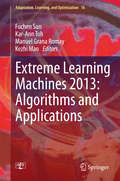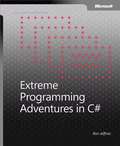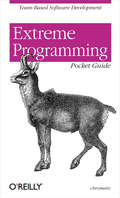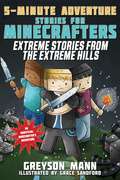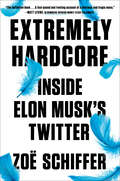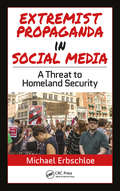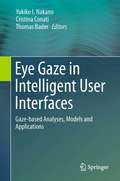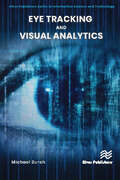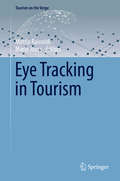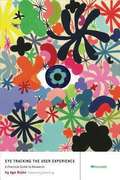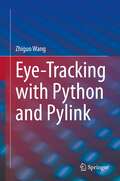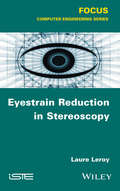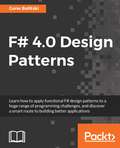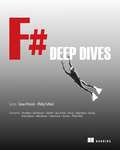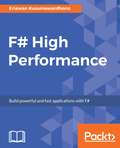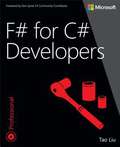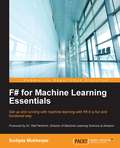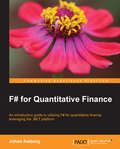- Table View
- List View
Extreme Events and Natural Hazards
by Vijay P. Dimri Daniel N. Baker A. Surjalal Sharma Armin BundePublished by the American Geophysical Union as part of the Geophysical Monograph Series, Volume 196.Extreme Events and Natural Hazards: The Complexity Perspective examines recent developments in complexity science that provide a new approach to understanding extreme events. This understanding is critical to the development of strategies for the prediction of natural hazards and mitigation of their adverse consequences. The volume is a comprehensive collection of current developments in the understanding of extreme events. The following critical areas are highlighted: understanding extreme events, natural hazard prediction and development of mitigation strategies, recent developments in complexity science, global change and how it relates to extreme events, and policy sciences and perspective. With its overarching theme, Extreme Events and Natural Hazards will be of interest and relevance to scientists interested in nonlinear geophysics, natural hazards, atmospheric science, hydrology, oceanography, tectonics, and space weather.
Extreme Learning Machines 2013: Algorithms and Applications
by Fuchen Sun Kar-Ann Toh Manuel Grana Romay Kezhi MaoIn recent years, ELM has emerged as a revolutionary technique of computational intelligence, and has attracted considerable attentions. An extreme learning machine (ELM) is a single layer feed-forward neural network alike learning system, whose connections from the input layer to the hidden layer are randomly generated, while the connections from the hidden layer to the output layer are learned through linear learning methods. The outstanding merits of extreme learning machine (ELM) are its fast learning speed, trivial human intervene and high scalability. This book contains some selected papers from the International Conference on Extreme Learning Machine 2013, which was held in Beijing China, October 15-17, 2013. This conference aims to bring together the researchers and practitioners of extreme learning machine from a variety of fields including artificial intelligence, biomedical engineering and bioinformatics, system modelling and control, and signal and image processing, to promote research and discussions of "learning without iterative tuning". This book covers algorithms and applications of ELM. It gives readers a glance of the newest developments of ELM.
Extreme Privacy: What It Takes to Disappear
by Michael BazzellMichael Bazzell has helped hundreds of celebrities, billionaires, and everyday citizens completely disappear from public view. He is now known in Hollywood as the guy that “fixes” things. His previous books about privacy were mostly REACTIVE and he focused on ways to hide information, clean up an online presence, and sanitize public records to avoid unwanted exposure. <p><p>This textbook is PROACTIVE. It is about starting over. It is the complete guide that he would give to any new client in an extreme situation. It leaves nothing out, and provides explicit details of every step he takes to make someone completely disappear, including document templates and a chronological order of events. The information shared in this volume is based on real experiences with his actual clients, and is unlike any content ever released in his other books.
Extreme Programming Adventures in C#
by Ron JeffriesSee eXtreme Programming (XP) in action at the hands of an XP master--and learn Microsoft .NET and C# programming in the process! In this fast-paced, hands-on exposition, Ron Jeffries--one of the leading voices and practitioners in the XP community--demonstrates that you can write well-designed, resilient code incrementally and safely, while minimizing your investment in speculative up-front design. As Jeffries builds his sample application, you get firsthand insights into what successful XP development looks like, complete with real-world challenges such as the eleventh-hour change order. For further practice and study, you can download all the author's code--including the missteps--so you can see XP and agile concepts in action and assess how they fit into your own work. Pair program with an XP master, discovering how to: Streamline and simplify the software development process Work more effectively as part of an XP development team Reduce missteps by designing, testing, and refining code in increments Receive clearer specifications and feedback from customers Write cleaner, more expressive code--and weed out more bugs Conserve resources by planning and reassessing progress as you go Maintain a sustainable work pace--and avoid burnout Step up delivery dates, shipping the most crucial features first Improve customer satisfaction!
Extreme Programming Adventures in C#
by Ronald JeffriesApply what you know about extreme programming and object- oriented design to learning C# and the Microsoft .NET Framework on the fly. Author Ron Jeffries, a leading voice and practitioner in the extreme programming movement, demonstrates how to apply its key concepts-including the use of customer stories, customer acceptance tests, and "Spikes"-and the fundamental techniques of Simple Design, Test-Driven Development, and Refactoring to create practical, NET-ready applications. You'll also learn how to use NUnit, a unit-testing tool for .NET languages. This essential, high-level reference provides the expert guidance, hands-on insights, and downloadable code you need to build an XML editor, a database application, a Web service, and other useful applications.
Extreme Programming Pocket Guide
by Chromatic<p>The <i>Extreme Programming Pocket Guide</i> covers XP assumptions, principles, events, artifacts, roles, and resources, and more. It concisely explains the relationships between the XP practices. If you want to adopt XP in stages, the <i>Extreme Programming Pocket Guide</i> will help you choose what to apply and when. Concise and easy to use, this handy pocket guide to XP is a must-have quick reference for anyone implementing a test-driven development environment. </p>
Extreme Programming Pocket Guide: Team-Based Software Development
by ChromaticExtreme Programming (XP) is a radical new approach to software development that has been accepted quickly because its core practices--the need for constant testing, programming in pairs, inviting customer input, and the communal ownership of code--resonate with developers everywhere. Although many developers feel that XP is rooted in commonsense, its vastly different approach can bring challenges, frustrations, and constant demands on your patience.Unless you've got unlimited time (and who does these days?), you can't always stop to thumb through hundreds of pages to find the piece of information you need. The Extreme Programming Pocket Guide is the answer. Concise and easy to use, this handy pocket guide to XP is a must-have quick reference for anyone implementing a test-driven development environment.The Extreme Programming Pocket Guide covers XP assumptions, principles, events, artifacts, roles, and resources, and more. It concisely explains the relationships between the XP practices. If you want to adopt XP in stages, the Extreme Programming Pocket Guide will help you choose what to apply and when. You'll be surprised at how much practical information is crammed into this slim volume.O'Reilly's Pocket Guides have become a favorite among developers everywhere. By providing a wealth of important details in a concise, well-organized format, these handy books deliver just what you need to complete the task at hand. When you've reached a sticking point in your work and need to get to a solution quickly, the new Extreme Programming Pocket Guide is the book you'll want to have beside your keyboard.
Extreme Stories from the Extreme Hills: 5-Minute Adventure Stories for Minecrafters (5-Minute Stories for Minecrafters #1)
by Grace Sandford Greyson MannWhile Audrey yearns for new adventures, her brother Oliver dreams of hidden treasures. When the twins explore different biomes, they find plenty of both in 5-Minute Adventures for Minecrafters, an all-new series of stories for Minecrafters that can be read in 5 minutes! In Extreme Stories from the Extreme Hills, Audrey and Oliver collect many treasures—and mini adventures. For every dangerous hike up a rocky cliff, there’s a waterfall roaring back down. Each dungeon hides a treasure chest—but also a monster spawner! As the mobs get deadlier, the stakes grow higher. The twins hope to make it back to Birchtown with their treasures in hand. Will the next ravine lead to riches or to a river of hot lava? There’s only one way to find out. These five-minute stories promise plenty of twists and turns—and surprise endings. In 5-Minute Adventures for Minecrafters: Extreme Stories from the Extreme Hills, the twins explore one of the Overworld’s most treacherous terrains, one exciting step at a time.
Extremely Hardcore: Inside Elon Musk's Twitter
by Zoë Schiffer"Zoë Schiffer has written the definitive book on perhaps the weirdest business story of our time. A fast-paced and riveting account of a hilarious and tragic mess."— Matt Levine, Bloomberg Opinion &“Money Stuff&” columnist&“the bird is freed&”- Elon Musk (@elonmusk) October 27, 2022When Elon Musk took over Twitter, commentators were rooting for the visionary behind Tesla and SpaceX to succeed. Here was a tough leader who could grab back power from Twitter&’s entitled workforce, motivate them to get &“extremely hardcore,&” and supercharge Twitter&’s profit and potential. And it was all out of the goodness of his own heart, rooted in his fervent belief in the necessity of making Twitter friendlier to free speech. "I didn&’t do it to make more money,&” Musk said. &“I did it to try and help humanity, whom I love.&” Once Musk charged into the Twitter headquarters, the command-and-control playbook Musk honed at Tesla and SpaceX went off the rails immediately. Distilling hundreds of hours of interviews with more than sixty employees, thousands of pages of internal documents, Slack messages, presentations, as well as court filings and congressional testimony, Extremely Hardcore is the true story of how Musk reshaped the world&’s online public square into his own personal megaphone. You&’ll hear from employees who witnessed the destruction of their workplace in real-time, seeing years of progress to fight disinformation and hate speech wiped out within a matter of months. There&’s the machine-learning savant who went all-in on Twitter 2.0 before getting betrayed by his new CEO, the father whose need for healthcare swept him into Musk&’s inner circle, the trust and safety expert who became the subject of a harassment campaign his former boss incited, and the many other employees who tried to save the company from their new boss&’s worst instincts. This is the story of Twitter, but it&’s also a chronicle of the post-pandemic labor movement, a war between executives and a workforce newly awakened to their rights and needs. Riveting, character-driven, and filled with jaw-dropping revelations, Extremely Hardcore is the definitive, fly-on-the-wall story of how Elon Musk lit $44 billion on fire and burned down Twitter. It&’s the next best thing to being there, and you won&’t have to sleep in the Twitter office to get the scoop.
Extremist Propaganda in Social Media: A Threat to Homeland Security
by Michael ErbschloeExtremist Propaganda in Social Media: A Threat to Homeland Security presents both an analysis of the impact of propaganda in social media and the rise of extremism in mass society from technological and social perspectives. The book identifies the current phenomenon, what shall be dubbed for purposes of this book "Blisstopian Societies"—characterized in the abiding "ignorance is bliss" principle—whereby a population is complacent and has unquestioning acceptance of a social doctrine without challenge and introspection. In these subcultures, the malleable population self-select social media content, "news," and propaganda delivery mechanisms. By doing so, they expose themselves only to content that motivates, reinforces, and contributes to their isolation, alienation, and self-regulation of the social groups and individuals. In doing this, objective news is dismissed, fake—or news otherwise intended to misinform—reinforces their stereotyped beliefs about society and the world around them. This phenomenon is, unfortunately, not "fake news," but a real threat to which counterterror, intelligence, Homeland Security, law enforcement, the military, and global organizations must be hyper-vigilant of, now and into the foreseeable future. Chapters cite numerous examples from the 2016 political election, the Russia investigation into the Trump Campaign, ISIS, domestic US terrorists, among many other examples of extremist and radicalizing rhetoric. The book illustrates throughout that this contrived and manufactured bliss has fueled the rise and perpetuation of hate crimes, radicalism, and violence in such groups as ISIS, Boko Haram, Neo-Nazis, white separatists, and white supremacists in the United States—in addition to perpetuating ethnic cleansing actions around the world. This dynamic has led to increased political polarization in the United States and abroad, while furthering an unwillingness and inability to both compromise or see others’ perspectives—further fomenting insular populations increasing willing to harm others and do violence. Extremist Propaganda in Social Media relates current Blisstopian practices to real-world hate speech and violence, connecting how such information is consumed by groups and translated into violent action. The book is an invaluable resources for those professionals that require an awareness of social media radicalization including: social media strategists, law enforcement, Homeland Security professionals, military planners and operatives—anyone tasked with countering combat such violent factions and fringes in conflict situations.
Exzellente Geschäftsprozesse mit SAP
by Egmont FothDer Einsatz von SAP ist eine Herausforderung, die alle Bereiche eines Unternehmens betrifft: Mitarbeiter müssen das notwendige Know-how aufbauen, um das System effektiv nutzen zu können; Unternehmensprozesse funktionieren umso besser, je enger sich die Organisation an das Standardprozessmodell anpasst; korrekte Stammdaten stellen den reibungslosen Ablauf der Supply-Chain-Prozesse sicher. Das Buch führt in Best-Practice-Prozesse ein und bietet zahlreiche praxiserprobte Tipps für den erfolgreichen Einsatz von SAP in Unternehmensgruppen.
Eye Gaze in Intelligent User Interfaces
by Cristina Conati Thomas Bader Yukiko I. NakanoRemarkable progress in eye-tracking technologies opened the way to design novel attention-based intelligent user interfaces, and highlighted the importance of better understanding of eye-gaze in human-computer interaction and human-human communication. For instance, a user's focus of attention is useful in interpreting the user's intentions, their understanding of the conversation, and their attitude towards the conversation. In human face-to-face communication, eye gaze plays an important role in floor management, grounding, and engagement in conversation. Eye Gaze in Intelligent User Interfaces draws on ideas from a number of contributors working on how attentional information can be applied to novel intelligent interfaces. Part I focuses on analyzing human eye gaze behaviors to reveal characteristics of human communication and cognition; Part II addresses estimation and prediction of the cognitive state of the users using gaze information; and Part III presents proposals of novel gaze-aware interfaces which integrate eye-trackers as a system component. The contributions highlight a direction for the future of human-computer interaction, and discuss issues in human attentional behaviors and face-to-face communication which are essential in designing gaze aware interactive interfaces.
Eye Tracking Methodology
by Andrew T. DuchowskiDespite the availability of cheap, fast, accurate and usable eye trackers, there is little information available on how to develop, implement and use these systems. This book aims to fill that gap in the market by providing an accessible introduction for practitioners and students. The first part of the book covers useful background information, including an introduction to the human visual system and key issues in visual perception and eye movement. The second part surveys eye-tracking devices and gives a detailed introduction to the technical requirements for installing a system and developing an application program. It focuses on video-based, corneal-reflection eye trackers - the most widely available and affordable type of system. The final part looks at a number of interesting and challenging applications in areas such as Human Factors, Collaborative Systems, Virtual Reality, Marketing and Advertising. Eye Tracking Methodology: Theory and Practice will be an invaluable guide for practitioners responsible for developing or implementing an eye tracking system. It will also be an invaluable teaching text for relevant modules on advanced undergraduate and postgraduate courses such
Eye Tracking and Visual Analytics
by Michael BurchVisualization and visual analytics are powerful concepts for exploring data from various application domains. The endless number of possible parameters and the many ways to combine visual variables as well as algorithms and interaction techniques create lots of possibilities for building such techniques and tools.The major goal of those tools is to include the human users with their tasks at hand, their hypotheses, and research questions to provide ways to find solutions to their problems or at least to hint them in a certain direction to come closer to a problem solution. However, due to the sheer number of design variations, it is unclear which technique is suitable for those tasks at hand, requiring some kind of user evaluation to figure out how the human users perform while solving their tasks.The technology of eye tracking has existed for a long time; however, it has only recently been applied to visualization and visual analytics as a means to provide insights to the users’ visual attention behavior. This generates another kind of dataset that has a spatio-temporal nature and hence demands for advanced data science and visual analytics concepts to find insights into the recorded eye movement data, either as a post process or even in real-time.This book describes aspects from the interdisciplinary field of visual analytics, but also discusses more general approaches from the field of visualization as well as algorithms and data handling. A major part of the book covers research on those aspects under the light and perspective of eye tracking, building synergy effects between both fields – eye tracking and visual analytics – in both directions, i.e. eye tracking applied to visual analytics and visual analytics applied to eye tracking data. Technical topics discussed in the book include: • Visualization; • Visual Analytics; • User Evaluation; • Eye Tracking; • Eye Tracking Data Analytics;Eye Tracking and Visual Analytics includes more than 500 references from the fields of visualization, visual analytics, user evaluation, eye tracking, and data science, all fields which have their roots in computer science.Eye Tracking and Visual Analytics is written for researchers in both academia and industry, particularly newcomers starting their PhD, but also for PostDocs and professionals with a longer research history in one or more of the covered research fields. Moreover, it can be used to get an overview about one or more of the involved fields and to understand the interface and synergy effects between all of those fields. The book might even be used for teaching lectures in the fields of information visualization, visual analytics, and/or eye tracking.
Eye Tracking in Tourism (Tourism on the Verge)
by Mario Jooss Mattia RainoldiDespite the ever-increasing interest in eye tracking, there is still no comprehensive work on the potential and applications of table-mounted and mobile head-mounted eye tracking solutions in travel and tourism. This volume bridges that gap, effectively linking eye tracking with travel and tourism. It presents, on the one hand, novel academic contributions on the concept of eye tracking, and on the other, practice-oriented case studies that illustrate the use and strategic value of eye tracking in travel and tourism. It provides concrete and novel insights into tourist behavior and the tourist consumer experience and, for the academic community, offers a comprehensive, scientifically based overview of the empirical, methodological, theoretical, and practical contributions of eye tracking research. Accordingly, the book will be of value to a diverse audience. It will be a useful resource for existing and future tourism businesses, allowing them to adopt proactive approaches in the design of tourism products. It will also stimulate further research in the field and inspire scholars and practitioners to combine their ideas and expertise, to look beyond supposedly fixed horizons, and to identify emerging opportunities.
Eye Tracking the User Experience
by Aga BojkoEye tracking is a widely used research method, but there are many questions and misconceptions about how to effectively apply it. Eye Tracking the User Experience--the first how-to book about eye tracking for UX practitioners--offers step-by-step advice on how to plan, prepare, and conduct eye tracking studies; how to analyze and interpret eye movement data; and how to successfully communicate eye tracking findings.
Eye-Tracking with Python and Pylink
by Zhiguo WangSeveral Python programming books feature tools designed for experimental psychologists. What sets this book apart is its focus on eye-tracking.Eye-tracking is a widely used research technique in psychology and neuroscience labs. Research grade eye-trackers are typically faster, more accurate, and of course, more expensive than the ones seen in consumer goods or usability labs. Not surprisingly, a successful eye-tracking study usually requires sophisticated computer programming. Easy syntax and flexibility make Python a perfect choice for this task, especially for psychology researchers with little or no computer programming experience.This book offers detailed coverage of the Pylink library, a Python interface for the gold standard EyeLink ® eye-trackers, with many step-by-step example scripts. This book is a useful reference for eye-tracking researchers, but you can also use it as a textbook for graduate-level programming courses.
Eyestrain Reduction in Stereoscopy
by Laure LeroyStereoscopy technology is interesting because it allows a quick immersion, especially when it is combined with other relief clues. However, it can cause stress on the visual system, and conflicts between different relief clues used by our visual system appear. This book exposes the mechanisms of depth perception with and without stereoscopy and indices which are involved in the depth perception. It continues with the techniques used to capture stereoscopic images and retransmit. The causes of eyestrain related to these images are then described and the consequences for longer or shorter terms. The study of these causes eyestrain basis for content improvement tracks to make for easier viewing.
F# 4.0 Design Patterns
by Gene BelitskiLearn how to apply functional F# design patterns to a huge range of programming challenges, and discover a smart route to building better applications About This Book * This book provides a path if you are coming from imperative and object-oriented paradigms * It will take you to an intermediate level of functional programming in very practical manner to write enterprise-quality idiomatic F# code * Tackle complex computing problems with simple code by fully embracing the functional-first F# paradigm * Packed full of practical coding examples to help you master F# programming and author optimal code Who This Book Is For This book is for .NET developers, web programmers, C# developers, and F# developers. So, if you have basic experience in F# programming and developing performance-critical applications, then this book is for you. What You Will Learn * Acquire the practical knowledge to use the main functional design patterns * Realign some imperative and object-oriented principles under the functional approach * Develop your confidence in building and combining first-order and higher-order functions * Learn to use core language pattern matching effectively * Make use of native F# algebraic data types in place of custom-built classes * Recognize and measure the difference in resource consumption between sequences and materialized data collections * Navigate and use F# Core libraries with ease by seeing patterns behind specific library functions * Master writing generic polymorphic code In Detail Following design patterns is a well-known approach to writing better programs that captures and reuses high-level abstractions that are common in many applications. This book will encourage you to develop an idiomatic F# coding skillset by fully embracing the functional-first F# paradigm. It will also help you harness this powerful instrument to write succinct, bug-free, and cross-platform code. F# 4.0 Design Patterns will start off by helping you develop a functional way of thinking. We will show you how beneficial the functional-first paradigm is and how to use it to get the optimum results. The book will help you acquire the practical knowledge of the main functional design patterns, the relationship of which with the traditional Gang of Four set is not straightforward. We will take you through pattern matching, immutable data types, and sequences in F#. We will also uncover advanced functional patterns, look at polymorphic functions, typical data crunching techniques, adjusting code through augmentation, and generalization. Lastly, we will take a look at the advanced techniques to equip you with everything you need to write flawless code. Style and approach This book will teach you how to write F# code in an idiomatic functional-first manner, thereby improving the productivity of F# programmers. This book is ideal for an F# programmer who wants using F# in functional-first way.
F# Deep Dives
by Tomas Petricek Phillip TrelfordSummaryF# Deep Dives presents a collection of real-world F# techniques, each written by expert practitioners. Each chapter presents a new use case where you'll read how the author used F# to solve a complex problem more effectively than would have been possible using a traditional approach. You'll not only see how a specific solution works in a specific domain, you'll also learn how F# developers approach problems, what concepts they use to solve them, and how they integrate F# into existing systems and environments.Purchase of the print book includes a free eBook in PDF, Kindle, and ePub formats from Manning Publications.About the TechnologyF# is an elegant, cross-platform, functional-first programming language. With F#, developers create consistent and predictable programs that are easier to test and reuse, simpler to parallelize, and less prone to bugs. The language, its tooling, and the functional programming style have proven effective in many application areas like secure financial engines, machine learning algorithms, scientific calculations, collaborative web applications, games, and more.About the BookF# Deep Dives is a selection of real-world F# techniques written by expert practitioners. Each chapter presents an important use case where you'll solve a real programming challenge effectively using F# and the functional-first approach. Not only will you see how a specific solution works in a specific domain, but you'll also learn how functional programmers think about problems, how they solve them, and how they integrate F# into existing systems and environments.Readers should have at least an introductory knowledge of the F# language.What's InsideNumerical computingData visualizationBusiness logicDomain-specific languagesPractical solutions to real problemsInformation-rich programming, including LINQ and F# type providersCovers F# 3.1 and VS 2013About the AuthorsTomas Petricek contributed to the development of the F# language at Microsoft Research. Phil Trelford is an early adopter of F# and one of its most vocal advocates. They are joined by F# experts Chris Ballard, Keith Battocchi, Colin Bull, Chao-Jen Chen, Yan Cui, Johann Deneux, Kit Eason, Evelina Gabasova, Dmitry Morozov, and Don Syme.Table of ContentsSucceeding with functional-first languages in the industryPART 1 INTRODUCTIONCalculating cumulative binomial distributionsParsing text-based languagesPART 2 DEVELOPING ANALYTICAL COMPONENTSNumerical computing in the financial domainUnderstanding social networksIntegrating stock data into the F# languagePART 3 DEVELOPING COMPLETE SYSTEMSDeveloping rich user interfaces using the MVC patternAsynchronous and agent-based programmingCreating games using XNABuilding social web applicationsPART 4 F# IN THE LARGER CONTEXTF# in the enterpriseSoftware quality
F# High Performance
by Eriawan KusumawardhonoBuild powerful and fast applications with F# About This Book • Explore the advanced concurrency support in F# and .NET TPL • Covers major optimization techniques in F# to improve the performance of applications • Use Struct, Class and Record model, Interop with C# and VB without sacrificing performance. Who This Book Is For This book is for F# developers who want to build high-performance applications. Knowledge of functional programming would be helpful. What You Will Learn • Understand how the execution of functions in F# works • Identify common performance bottlenecks • Implement best practices to optimize performance • Use the available tooling to help measure performance • Combine the best practice of asynchronous and synchronous • Optimize further using various F# language constructs In Detail F# is a functional programming language and is used in enterprise applications that demand high performance. It has its own unique trait: it is a functional programming language and has OOP support at the same time. This book will help you make F# applications run faster with examples you can easily break down and take into your own work. You will be able to assess the performance of the program and identify bottlenecks. Beginning with a gentle overview of concurrency features in F#, you will get to know the advanced topics of concurrency optimizations in F#, such as F# message passing agent of MailboxProcessor and further interoperation with .NET TPL. Based on this knowledge, you will be able to enhance the performance optimizations when implementing and using other F# language features. The book also covers optimization techniques by using F# best practices and F# libraries. You will learn how the concepts of concurrency and parallel programming will help in improving the performance. With this, you would be able to take advantage of multi-core processors and track memory leaks, root causes, and CPU issues. Finally, you will be able to test their applications to achieve scalability. Style and approach This easy-to-follow guide is full of hands-on examples of real-world multithreading tasks. Each topic is explained and placed in context, and for the more inquisitive, there are also more in-depth details of the concepts used.
F# for C# Developers
by Tao LiuExtend your C# skills to F#--and create data-rich computational and parallel software components faster and more efficiently. Focusing on F# 3.0 and Microsoft Visual Studio 2012, you'll learn how to exploit F# features to solve both computationally-complex problems as well as everyday programming tasks. Topics include: C# and F# data structures; F# for functional, object-oriented, and imperative programming; design patterns; type providers; and portable support for Windows 8. You'll examine real-world applications, including Windows 8-style HTML5 and JavaScript apps, along with cloud and service apps. You'll write your own type provider. And you'll see how to expand F# computation power to high-performance GPU computing.
F# for Machine Learning Essentials
by Sudipta MukherjeeGet up and running with machine learning with F# in a fun and functional way About This Book * Design algorithms in F# to tackle complex computing problems * Be a proficient F# data scientist using this simple-to-follow guide * Solve real-world, data-related problems with robust statistical models, built for a range of datasets Who This Book Is For If you are a C# or an F# developer who now wants to explore the area of machine learning, then this book is for you. Familiarity with theoretical concepts and notation of mathematics and statistics would be an added advantage. What You Will Learn * Use F# to find patterns through raw data * Build a set of classification systems using Accord.NET, Weka, and F# * Run machine learning jobs on the Cloud with MBrace * Perform mathematical operations on matrices and vectors using Math.NET * Use a recommender system for your own problem domain * Identify tourist spots across the globe using inputs from the user with decision tree algorithms In Detail The F# functional programming language enables developers to write simple code to solve complex problems. With F#, developers create consistent and predictable programs that are easier to test and reuse, simpler to parallelize, and are less prone to bugs. If you want to learn how to use F# to build machine learning systems, then this is the book you want. Starting with an introduction to the several categories on machine learning, you will quickly learn to implement time-tested, supervised learning algorithms. You will gradually move on to solving problems on predicting housing pricing using Regression Analysis. You will then learn to use Accord.NET to implement SVM techniques and clustering. You will also learn to build a recommender system for your e-commerce site from scratch. Finally, you will dive into advanced topics such as implementing neural network algorithms while performing sentiment analysis on your data. Style and approach This book is a fast-paced tutorial guide that uses hands-on examples to explain real-world applications of machine learning. Using practical examples, the book will explore several machine learning techniques and also describe how you can use F# to build machine learning systems.
F# for Quantitative Finance
by Johan AstborgTo develop your confidence in F#, this tutorial will first introduce you to simpler tasks such as curve fitting. You will then advance to more complex tasks such as implementing algorithms for trading semi-automation in a practical scenario-based format.If you are a data analyst or a practitioner in quantitative finance, economics, or mathematics and wish to learn how to use F# as a functional programming language, this book is for you. You should have a basic conceptual understanding of financial concepts and models. Elementary knowledge of the .NET framework would also be helpful.
F# in Action (In Action)
by Isaac AbrahamF# is engineered to make functional programming practical and accessible. This book will get you started writing your first simple, robust, and high performing functional code.F# lets you keep your code simple even in the most complex applications—and it&’s the perfect language for taking your first steps in functional programming. This practical, example-driven guide shows you how to build professional applications the F# way. In F# in Action you will learn how to: Write performant and robust systems with succinct F# code Model domains quickly, easily and accurately with F#&’s type system Design solutions using functional programming patterns Ingest and process disparate data sources Develop data-driven web applications Unit test F# code Effectively model data using a variety of techniques Use scripts to rapidly explore domains F# in Action is based on author and Microsoft F# MVP Isaac Abraham&’s years of experience working with developers as an F# consultant. It upgrades .NET development skills with the core principles of functional programming, and you&’ll soon see how F#&’s functional-first approach makes it easy to learn this powerful paradigm. Forewords by Phillip Carter and Tomas Petricek. About the technology F# is a uniquely powerful programming language. Its &“light touch&” approach to functional programming helps you deliver error-free code without a lot of complex math and academic theory. Simply put, F# exists to help you write better software faster, and this book will show you how. About the book F# in Action teaches you to write professional quality applications in F#. For each concept, feature, and technique you&’ll find hands-on examples, starting with simple data transformations and progressing all the way to a full-size web app. Throughout the book, you&’ll take advantage of battle-tested .NET tools to take on a wide range of tasks—from data analysis to interoperability with C#. What's inside Model domains with F#&’s type system Ingest and process disparate data sources Unit test F# code Use scripts to rapidly explore domains About the reader For readers comfortable with any OO or FP language. Prior .NET knowledge not required! About the author Isaac Abraham is an experienced .NET developer, trainer, and Microsoft MVP for his contributions to the .NET community. Technical editor on this book was Michael Ciccotti. Table of Contents 1 Introducing F# 2 Hands on with F# 3 F# Syntax Basics 4 F# Fundamentals 5 Shaping data 6 Functions and modules 7 Working with collections 8 Patterns and unions 9 Building rich domains 10 Working effectively with data 11 F# Interop 12 Asynchronous programming 13 Web programming 14 Testing F# code 15 Pure functional programming 16 Where next?

